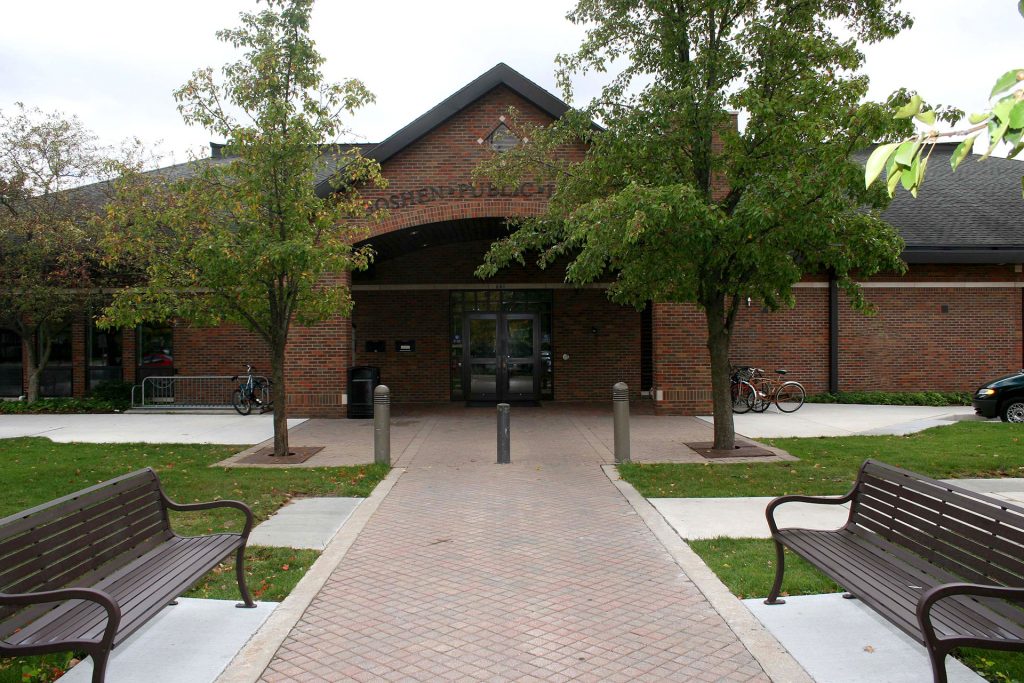
About
Goshen Public Library, Goshen, Indiana
This building housed 50,989 library materials when it was originally constructed in 1968. It served a population of 19,022 with 8,468 cardholders. In 1994 the Library completed a major renovation project. The Library now houses over 186,000 items serving a population close to 37,500 with nearly 20,000 cardholders.
The main level of the Library provides Adult and Young Adult Services, Reference Services, and the Indiana Collection. Located on the lower level of the Library are Children’s Services, Audiovisual Services, Technical Services, and meeting rooms.
The Library is supported by taxes from the City of Goshen and Elkhart Township. The Library is administered by the Executive Director and governed by a seven-member board of directors appointed by local authorities.

Goshen Public Library Beginnings
In the latter part of the 19th Century there were literary clubs in Goshen that got together for the purpose of reading and study. They were primarily women’s groups, and during the course of their studies, they began collecting books which they kept in the home of a member of the club. Early clubs were called the Philomathian Club, the Beacon Lights, the Library Club, the Bay View Club and the Chautauqua Club. These groups became interested in developing a library and began efforts to raise money to buy books and start a building fund. As a result of the interest stimulated by these women’s organizations, a public meeting was held to organize a library association on January 22, 1897.
The subsequently organized association drew up and adopted a constitution and by-laws. They conducted a membership drive selling subscriptions at one dollar each. $308 was raised for the purchase of new books. They housed the library over a store and were open every Saturday from 2 to 5 p.m. and 7 to 9 p.m. and Monday from 2 to 5 p.m. On January 25, 1900, the library association was incorporated under the name of the Goshen Library Association.
During the years 1899 to 1900 Mr. C. A. Davis, a Goshen resident, learned from his son-in-law who lived in Pittsburgh, Pennsylvania, about the largess of Andrew Carnegie in donating money for library buildings. Library Board members were quick to contact Mr. Carnegie and begin negotiations for a donation for a library in Goshen. On December 20, 1900, Board Members I.O. Wood and E.E. Mummert went to New York to confer with James Bertram, Carnegie’s private secretary. Shortly thereafter they received a letter dated January 15, 1901, granting them $15,000 to build a library if the city would pass a resolution to tax itself for the maintenance of the library and provide a proper site. Goshen’s Mr. Mummert was a State Represenative.
Through his efforts, the Indiana General Assembly passed legislation which permitted local units of government to levy tax for the perpetuation and maintenance of all libraries built in Indiana by Mr. Carnegie. This allowed Goshen’s Carnegie grant process to move forward since Goshen could now meet Mr. Carnegie’s stipulation. The city council passed Ordinance No. 136 on April 1, 1901, under the provisions of the Mummert Library Law. The General Assembly’s library law paved the way so that other libraries in Indiana could now receive grants also. Goshen’s grant was the first in Indiana, but many soon followed, and more Indiana communities received Carnegie grants than in any other state. An additional $10,000 was granted to Goshen within a year of the first promise of monies making the total Carnegie allottment to Goshen $25,000.
1901 was a year of planning and organizing for the new library. Patton and Miller from Chicago were chosen to design the building. They were among the most prolific library designers of that time. The cornerstone for the new building was laid on January 2, 1902. The Carnegie Library building was constructed of Bedford limestone in the Beaux- Art style of architecture. It is considered a very fine example of this type of library which was popular in the midwest. The Beaux-Art style accounts for about 18 percent of all Carnegie buildings. Its features include entrances within monumental arches, stone exterior walls with either invisible or exaggerated horizontal course lines, and details such as lavishly ornamented keystones, paired columns, pilasters, floral swags, shields, and escutcheons.
The dedication and opening service for the new Carnegie Library took place on January 15, 1903. The building was open to the public from 7 p.m. until the program closed at 10 p.m. There was an auditorium in the basement of the building that had seats for 275 people. All seats were filled for the dedication program and all available standing room was taken. Hundreds who wished to hear the program could not gain admittance. The opening of the new Carnegie Library was an important community event.
